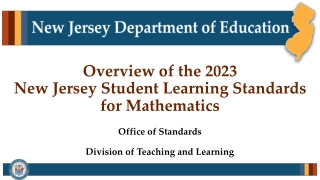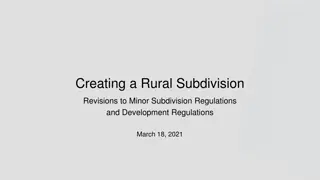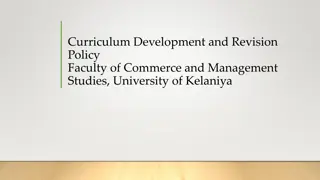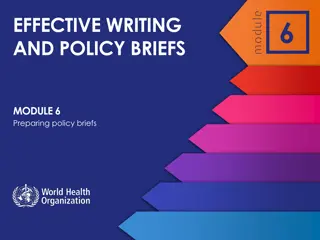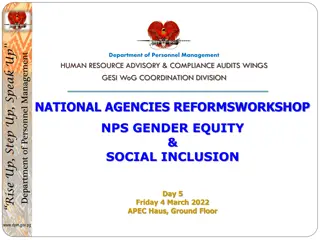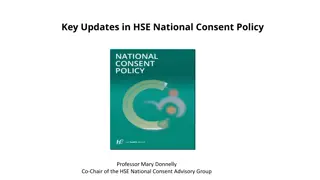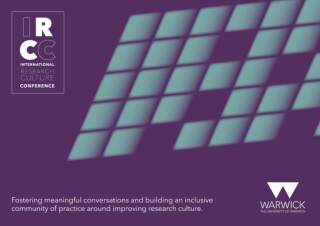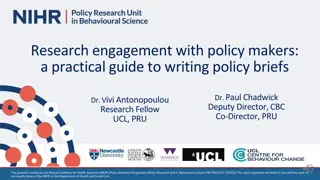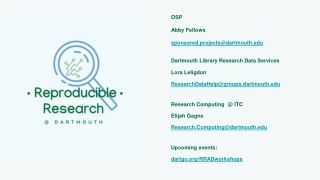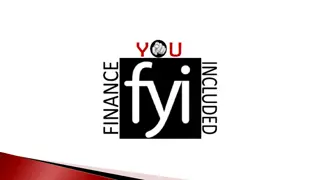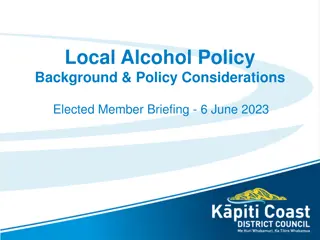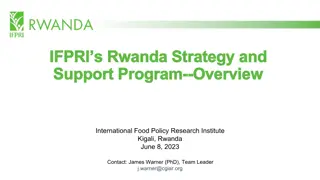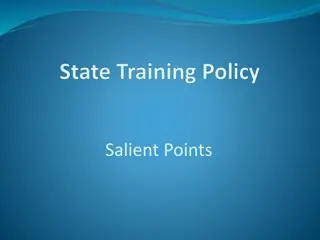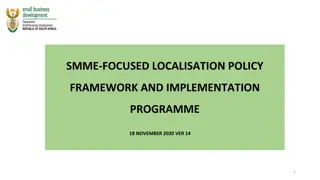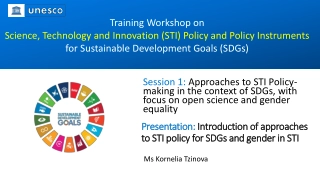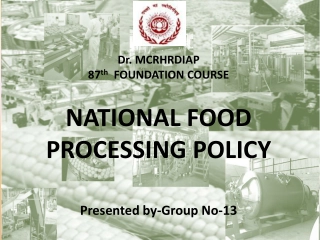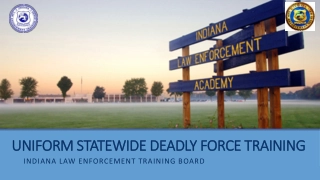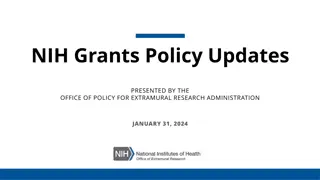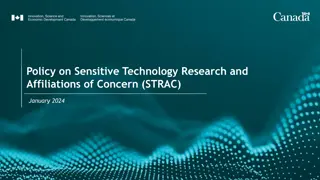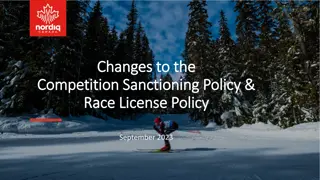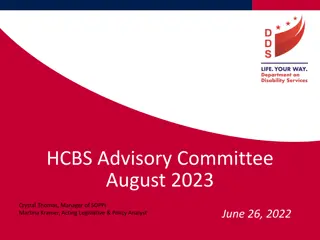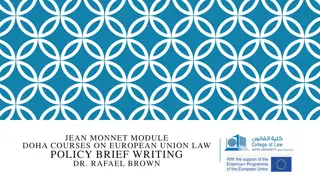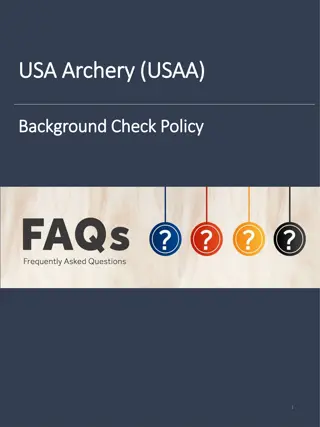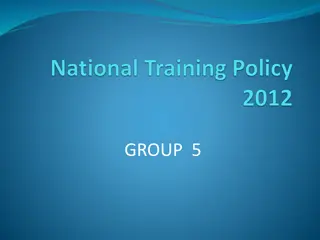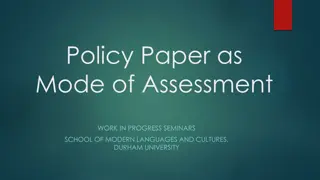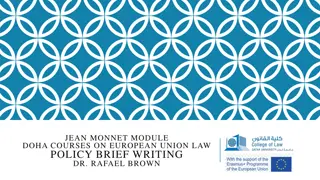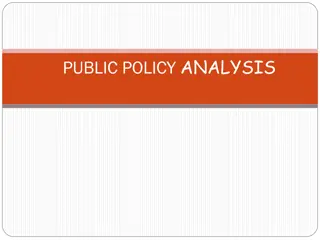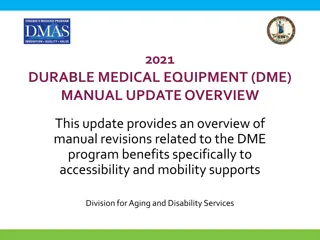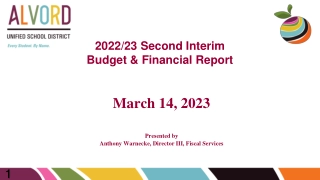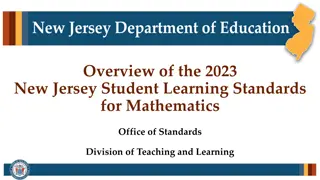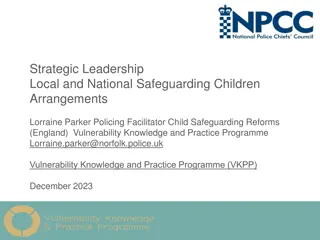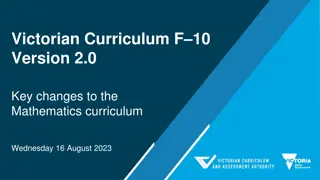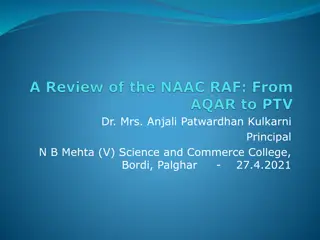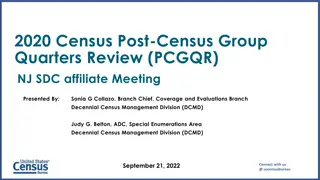Overview of Policy 2419 Revisions
Explore the latest revisions to Policy 2419 effective from March 2023, influenced by legislation, stakeholder feedback, and expert guidance. The revisions address various categories and reflect input from diverse educational stakeholders.
Download Presentation

Please find below an Image/Link to download the presentation.
The content on the website is provided AS IS for your information and personal use only. It may not be sold, licensed, or shared on other websites without obtaining consent from the author. Download presentation by click this link. If you encounter any issues during the download, it is possible that the publisher has removed the file from their server.
E N D
Presentation Transcript
WVBE Policy 2419 Overview of Revisions and Changes Effective March 2023
Policy 2419 Revisions Policy 2419 Revisions Last revised in August 2017 Revised Effective November 14, 2022 New revisions in effect - March 2023 Current revision necessitated by: Contemporary legislation and case law Guidance from technical assistance centers Guidance from Office of Special Education Programs (OSEP) Stakeholder input Updated internal practices Updated 2/6/23 2
Policy 2419: Comment Period Policy 2419: Comment Period 318 comments received during initial public comment period 32 comments received following a stakeholder meeting regarding the changes to the developmental delay category Many comments received pertained to overlapping issues or concerns More than 100 comments received resulted in further changes and revisions to the originally proposed policy to reflect stakeholder input https://apps.sos.wv.gov/adlaw/csr/readfile.aspx?DocId=55901&For mat=PDF 3
Policy 2419: Comment Period Policy 2419: Comment Period Comments were received from the following groups: LEA Board of Education staff Special Education Specialists Library Media Specialists Teachers and Co-Teachers Special Education Teachers Visual Impairment Teachers Gifted Teachers Occupational Therapists Retired Teachers Parents Citizens Others Attorneys Educational Diagnosticians Education Recovery Specialists Advocacy Specialists LEA Coordinators (psychological services, special education, preschool special needs) Speech-Language Pathologists School Psychologists Directors of advocacy centers Directors of Special Education Directors of Early Childhood Programs / Preschool 4
Changes at a Glance Changes at a Glance Updates related to: Policy language and terminology, including provisions related to charter public schools Procedural changes Alignment of language with federal, state, and board policy, as well as case law Glossary and acronym lists Glossary has been moved to the front of the document Clarifications of existing policy content 5
Changes at a Glance Changes at a Glance Updates related to: Eligibility criteria and language for certain disability categories Visual impairment, developmental delay, emotional disturbance, specific learning disabilities, speech or language impairment IEPs, caseloads, special education services, and related procedures LRE and classrooms Waivers Typographical, formatting, and technical revisions 6
Legislative Rule 126 CSR 16 Legislative Rule 126 CSR 16 Inclusion of charter public schools, and private schools where students are placed at expense of the State Added definitions of: Local Educational Agency (LEA) Parent Adult Student Minor Changes related to filing and effective dates, format, style, and terminology 7
Acronyms and Abbreviations Acronyms and Abbreviations Added APRN - Advanced Practice Registered Nurse DARF - Disciplinary Action Review Form ECCAT - Early Childhood Classroom Assistant Teacher GEFT - General Education: Full-Time GEPT - General Education: Part-Time PEP - Personalized Education Plan PA - Physician s Assistant WVBE West Virginia Board of Education Removed Various terms that are no longer relevant, or that do not necessarily belong in Policy 2419 8
Definitions (formerly Glossary) Definitions (formerly Glossary) Moved to the front of the document after Acronyms and Abbreviations Removed Individualized Family Service Plan (IFSP) Consultation Day; School Day Destruction 9
Definitions (formerly Glossary) Definitions (formerly Glossary) Added Adult Student Disability Exceptionality General Education: Full-Time (GEFT) General Education: Part-Time (GEPT) Individuals with Disabilities Education Improvement Act of 2004 Personalized Education Plan (PEP) Resource Room Self-Contained Special Education Classroom Student Assistance Team (SAT) Supported Decision-Making (SDM) Targeted IEP Review 10
Definitions (formerly Glossary) Definitions (formerly Glossary) Revised Eligible Students with Disabilities General Education Indirect Services Instructional Day Local Educational Agency (LEA) Meeting Placement Transition Services Behavior Intervention Plan Case Management Communication Consent Co-teaching Day Early Learning Programs Most definitions were revised to: more accurately reflect the meaning of the term, condense the definition for clarity, or add clarifications 11
Introduction Introduction Minor Changes Format and style Terminology Moving toward using Local Educational Agency (LEA) rather than county or school district 12
Chapter 1: Chapter 1: Free Appropriate Public Education Inclusion of charter public schools, and private schools where students are placed at expense of the State FAPE obligations apply to students who have not turned 21 prior to July 1 (previously September 1) Replaced standard diploma with regular diploma to be consistent with federal language Clarified that FAPE ends when a student with a disability has been exited from special education or graduates with a regular high school diploma. Minor Changes include format, style, terminology, and updates regarding policy language and titles 13
Chapter 2: Chapter 2: Child Find Clarifications There are no exemptions from Child Find responsibilities during national emergencies or health crises. Charter public schools, acting as their own LEA, are responsible for Child Find within their own schools. LEAs should ensure a smooth transition to the LEA prior to the student s third birthday for children receiving services through WVDHHR A teacher may refer a student suspected of needed special education and related services (previously read, "a parent or other interested party") Charter public schools are responsible for this location, identification, and evaluation process for students enrolled in their schools. 14
Chapter 2: Chapter 2: Child Find Clarifications Students entering K or PK may not require screening if they have passed a relevant screening previously SAT should receive annual training in all relevant procedures Student needs should be reviewed at least once per grading period for any student in the SAT process The options to consider when concluding the SAT process for students referred for multidisciplinary evaluation (i.e., to close the case, or refer student for further evaluation) Added social/emotional to potential student needs in the section on the SAT process Minor Changes include format, style, and terminology 15
Chapter 3: Chapter 3: Evaluation / Reevaluation 80-Day Initial Evaluation Timeline Clarification for #1 and #4 The 80-day timeline does not apply to a LEA if: 1. the parent repeatedly fails or refuses to produce the student for evaluation [34 CFR 300.301(d)]. 4. LEAs are closed due to weather conditions determined by the county superintendent, and no remote options are required. The timeline will be extended directly proportional to the duration of the weather conditions. Days missed must be clearly documented in the student s file to accurately record the interruption. If a LEA is closed due to weather conditions with remote learning options, this timeline is not extended. 16
Chapter 3: Chapter 3: Evaluation / Reevaluation 80-Day Initial Evaluation Timeline Clarification 17
Chapter 3: Chapter 3: Evaluation / Reevaluation Added under the sources of evaluation data teams may review as part of an initial evaluation: "1. evaluations and information provided by the parent/adult student; 2. data regarding the student s response to scientific evidence-based and/or research-based interventions using: a. current classroom-based assessments and classroom-based observations; b. observations by teachers and related service providers; c. results from statewide and LEA-wide testing; and/or 3. current evaluations received or on file in the LEA that are less than three years old for a student who was formerly entitled to special education services, exited public school due to home schooling, and is re-enrolling in the LEA. In this case, a review of existing evaluation data should expedite the eligibility determination. 18
Chapter 3: Chapter 3: Evaluation / Reevaluation Clarification - Timeline when Additional Testing is requested: The 60-day timeline will be extended for an LEA over summer break. The timeline will stop on the last day of instruction for the school year and resume on the first instructional day the following school year. Made the following statement its own numbered bullet point under Evaluation Procedures and Instruments e. For a child who is deaf or hard of hearing, a comprehensive language assessment in the child s language and communication mode must be included in his/her comprehensive evaluation Minor Changes include format, style, and terminology 19
Chapter 4: Chapter 4: Eligibility Removed redundant bullet from the three prongs of eligibility under Section 1. Eligibility Determination 4. No longer meets the eligibility criteria or no longer needs specially designed instruction. Added advanced practice registered nurse (APRN), physician assistant (PA) as additional clinical professionals who can render medical diagnoses for the categories of Autism, Orthopedic Impairment, Other Health Impairment, and Traumatic Brain Injury A. Autism Added also referred to as Autism Spectrum Disorder (ASD) to the definition to be consistent with contemporary terminology 20
Chapter 4: Chapter 4: Eligibility B. Blindness and Low Vision Modified Definition of Visual Impairment to ''Visual impairment including blindness means an impairment in vision that, even with correction, adversely affects a child s educational performance. The term includes both partial sight and blindness." Removed qualifiers under examples. Changed acuity requirement to "decreased visual acuity even with corrections, and changed visual field qualifier to "a visual field restriction." C. Deafblindness Added or neurologist as an additional clinical professional who can render vision loss diagnoses 21
Chapter 4: Chapter 4: Eligibility (Developmental Delay) The definition has been revised as follows to allow more flexibility in assessment: Developmental delays occur in students, ages three through five, who are functioning at, or lower than, 75 percent of the normal rate of development, or who perform 1.5 standard deviations or more below the mean in consideration of 1.0 standard error of measurement on a standardized evaluation instrument, in two or more of the following areas: 22
Chapter 4: Chapter 4: Eligibility (Developmental Delay) 23
Chapter 4: Chapter 4: Eligibility (Developmental Delay) In response to stakeholder input from various groups, the age range for Developmental Delay has been expanded as follows: Effective July 1, 2023, the age range defined for developmental delay will be extended to include ages three through six. (i.e., up to age seven) Effective July 1, 2024, the age range defined for developmental delay will be extended to include ages three through seven. (i.e., up to age eight) Updated 2/6/23 24
Chapter 4: Chapter 4: Eligibility (Developmental Delay) Further, Special Consideration # 7 now states students who are eligible for developmental delay during the 2022-2023 school year after the Policy 2419 effective date shall remain eligible through the end of the school year during which the student turns 6. For example, a student eligible for developmental delay who turns six in January 2023 can remain eligible for services until the end of the school year, rather than exiting or reevaluating the student by the student s sixth birthday. 25
Chapter 4: Chapter 4: Eligibility (Developmental Delay) Special Considerations # 3 and # 4 Removed the option to develop or use an Individual Family Service Plan (IFSP) - an IEP is now the only option Special Consideration # 7 Revised to reflect the age range expansion rollout Three more special considerations (8, 9, and 10) have been added to add clarifications and specify limitations of the age range expansion 26
Chapter 4: Chapter 4: Eligibility (Developmental Delay) Special Consideration #7 At the end of the school year during which the student reaches age six (which will change to age seven beginning July 1, 2023, and will change to age eight beginning July 1, 2024), or in cases where the student reaches age six (which will change to age seven beginning July 1, 2023, and will change to age eight beginning July 1, 2024) during the following summer, the student no longer meets the eligibility criteria for developmental delay; therefore, the IEP Team must follow procedures for reevaluation and reconvene the EC prior to the start of the following school year during which the student would begin at age six (which will change to age seven beginning July 1, 2023, and will change to age eight beginning July 1, 2024) to determine if the student meets eligibility under another exceptionality or will no longer be eligible for special education services . Updated 2/6/23 27
Chapter 4: Chapter 4: Eligibility (Developmental Delay) Special Consideration #8 Initial eligibility under the category of developmental delay must be determined before the student s sixth birthday. That is, a student may not undergo initial evaluation at age six or older and be identified as a student with a developmental delay. Special Consideration #9 Other disability categories should be considered if the EC can make a clear and conclusive determination under another category besides developmental delay. That is, if a student s difficulties are better explained by another disability category, and the student meets the specific criteria for that category, then that category should be used instead of developmental delay. 28
Chapter 4: Chapter 4: Eligibility (Developmental Delay) Special Consideration #10 As is the case for all students with disabilities, students served under developmental delay are entitled to benefit from intervention and supports provided through an MTSS framework in addition to special education and related services, particularly if eligibility under SLD may be considered in the future; tiered intervention, intervention documentation, and frequent progress monitoring are critical for the determination of SLD. That is, a student served under the category of developmental delay who is approaching the age limit must still meet the criteria for any other category as stated in WVBE Policy 2419 for the student to become eligible under a different category. 29
Chapter 4: Chapter 4: Eligibility (Developmental Delay) Certification and the Age Range Expansion For students in pre-k, special education services can be provided by: Special educators with a Preschool Special Needs endorsement (4120, 4121, 4122) Special educators with a Developmental Delay endorsement (4123) For students in kindergarten, special education services can be provided by: Special educators with a Preschool Special Needs endorsement (4120, 4121, 4122) Special educators with a Developmental Delay endorsement (4123) Special educators with a Multi-Categorical (4115) endorsement For students in first or second grade, special education services can be provided by: Special educators with a Developmental Delay endorsement (4123) Special educators with a Multi-Categorical (4115) endorsement Updated 2/6/23 30
Chapter 4: Chapter 4: Eligibility Emotional/Behavioral Disorder has been renamed "Emotional Disturbance" for consistency with federal language The definition and criteria are unchanged Reference to WVEIS on the Web Interventions Tab has been removed L. Specific Learning Disability Added mental health to the needs potentially addressed by MTSS Added The determination of eligibility for SLD services should be made using an MTSS framework. Removed the language related to the MTSS process as this content is more appropriate for inclusion in guidance documents rather than board policy 31
Chapter 4: Chapter 4: Eligibility (Speech or Language Impairment) M. Speech or Language Impairment Changes Changed the eligibility category title to Speech or Language Impairment from Speech/Language Impairment Moved all speech-language charts, resources, and developmental norm information from the Appendices to the Speech-Language Pathology Services in West Virginia Schools: Guidance for West Virginia Schools and Districts, 2022 Reorganized all Speech or Language Impairment Eligibility Criteria to correlate with the three prongs of eligibility 32
Chapter 4: Chapter 4: Eligibility (Speech or Language Impairment) M. Speech or Language Impairment Changes Added Summary Assessment Forms for Speech Sound Disorders, Language Disorders, Child Onset Fluency Disorder, and Voice Disorders Comprehensive Assessments are expected for all five areas of eligibility 33
Chapter 4: Chapter 4: Eligibility (Speech or Language Impairment) 34
Chapter 4: Chapter 4: Eligibility (Speech or Language Impairment) Eligibility Criteria 1. Diagnostic information demonstrates the disorder or impairment. (S-L Probes and Standardized S-L Tests and Measures); 2. Adverse impact on educational, vocational, or social- communicative performance (Academic Activities and Academic Tests and Measures); and 3. Need for specially-designed instruction. Three-Pronged Eligibility meets the state eligibility criteria in one of the designated exceptionalities: experiences an adverse impact on educational performance; and needs special education (specially designed instruction). 1. 2. 3. 35
Chapter 4: Chapter 4: Eligibility (Speech or Language Impairment) Language Disorder Changes Added the updated categorization terminology of form, use, and content to the Language Disorder: Diagnostic Criteria definition Updated the onset of Language Disorder to include not on the early developmental period, but when academic language demands in the classroom increase Added the use of a Functional Communication Summary for students who cannot participate in the assessment process 36
Chapter 4: Chapter 4: Eligibility (Speech or Language Impairment) Language Disorder Eligibility Criteria Simplified the description of acceptable diagnostic accuracy for standardized language assessments Updated the statement at the beginning of the Eligibility Criteria section to include current terminology Following consideration of the child s age, culture, language background, or dialect, an EC will determine that a student is eligible for special education and/or related services as a student who has a language disorder when the following criteria are met. 37
Chapter 4: Chapter 4: Eligibility (Speech or Language Impairment) Language Disorder Eligibility Criteria Continued (Provided speech-language pathologist the ability to use professional judgement to select the Comprehensive Assessment Components to address the individual needs of each student.) 1. Three or more speech-language probes or standardized speech-language assessments as listed below are performed as part of the comprehensive language evaluation process. For students who cannot participate in the assessment process, consider the use of the Functional Communication Assessment Summary see Speech-Language Pathology Services in WV: Guidance for West Virginia Schools and Districts. A student with a language disorder exhibits at least three of the following characteristics of a through e: 38
Chapter 4: Chapter 4: Eligibility (Speech or Language Impairment) Language Disorder Eligibility Criteria Continued a. assessment on a composite norm-referenced test of both receptive and expressive language with a diagnostic accuracy (sensitivity/specificity) of 80 percent or higher yields one or more composite scores that align with those who have a language disorder based on the test publisher s recommended cut score. Note: Only composite test scores may be used. Individual subtest scores may not be considered; b. language sample analysis results in a score of at least 1.5 standard deviations or more below similar-aged peers (e.g., +/- 6 months) at least two measures of productivity and/or complexity; 39
Chapter 4: Chapter 4: Eligibility (Speech or Language Impairment) Language Disorder Eligibility Criteria Continued c. dynamic assessment (test-teach-retest) that demonstrates limited or very limited improvement (see Speech-Language Pathology Services in West Virginia Schools: Guidance for West Virginia Schools and Districts, 2022); d. in conjunction with item a (above), norm-referenced test(s) for specific components or processes of language which do not meet the 80 percent diagnostic accuracy, or development scale(s), or criterion- based assessment(s) indicate that the student s language skills are lower than expected for their age; and/or e. case history, observation, parent and teacher interviews, and informal assessment(s) indicate the student has difficulty understanding or expressing ideas or concepts to such a degree that it significantly interferes with social interaction or educational progress, except for preschool, which is a socio-communicative impact. 40
Chapter 4: Chapter 4: Eligibility (Speech or Language Impairment) Language Disorder Eligibility Criteria Continued 2. The student s disability adversely affects educational or vocational performance, or social-communicative performance in the case of preschoolers, as shown by a review of the educational activities and LEA-wide assessments. (See Speech-Language Pathology Services in West Virginia Schools: Guidance for West Virginia Schools and Districts, 2022). 3. The student needs special education. (Language disorder can be a primary special education or related service.) language disorder is not considered the primary disability when the symptoms are attributable to hearing or other impairments that are more appropriately defined under another eligibility category. A language disorder is considered a related service when services are required to assist an eligible student with a disability to benefit from special education. 41
Chapter 4: Chapter 4: Eligibility (Speech or Language Impairment) 42
Chapter 4: Chapter 4: Eligibility (Speech or Language Impairment) Language Disorder Language Summary Assessment Form Headings 43
Chapter 4: Chapter 4: Eligibility (Speech or Language Impairment) Language Disorder - No Apparent or Minimal Impact 44
Chapter 4: Chapter 4: Eligibility (Speech or Language Impairment) Language Disorder - Moderate or Substantial Impact 45
Chapter 4: Chapter 4: Eligibility (Speech or Language Impairment) Speech Sound Disorder (Articulation/Phonology Disorder) Changes Added the Diagnostic Criteria to include onset of symptoms after an acquired brain injury Updated the characteristics for a Speech Sound or Phonological Disorder Added the use of a Speech Sound Production Summary Added the use of a Functional Communication Summary 46
Chapter 4: Chapter 4: Eligibility (Speech or Language Impairment) Speech Sound Disorder Eligibility Criteria An EC will determine that a student is eligible for special education and/or related services as a student who has a speech sound disorder when the following criteria are met. 1. Three or more speech probes or standardized speech assessments listed below and application of developmental norms (see Speech- Language Pathology Services in West Virginia Schools: Guidance for West Virginia Schools and Districts, 2022) are performed as part of the comprehensive speech sound evaluation process. For students who cannot participate in the assessment process, consider using the Functional Communication Assessment Summary (see Speech- Language Pathology Services in West Virginia Schools: Guidance for West Virginia Schools and Districts, 2022). The student with a speech sound disorder exhibits three of the following characteristics in a through e: 47
Chapter 4: Chapter 4: Eligibility (Speech or Language Impairment) Speech Sound Disorders Eligibility Criteria a. a standardized speech assessment demonstrates three or more phonemic errors not expected at the student s current age or developmental level are observed during direct testing and/or conversational speech; b. one or more phonological processes designated on the Speech Production Assessment Summary (see Speech-Language Pathology Services in West Virginia Schools: Guidance for West Virginia Schools and Districts, 2022) as a moderate to substantial are observed during direct testing and/or in conversational speech; c. the student is less than 59 percent stimulable for age-appropriate phonemic errors as listed on the Speech Production Assessment Summary (see Speech-Language Pathology Services in West Virginia Schools: Guidance for West Virginia Schools and Districts, 2022); d. the student s speech intelligibility is below the expected range and not due to influences of a second language or dialect. Intelligibility ratings as documented by school staff or caregivers indicate an impact across environments (see Speech-Language Pathology Services in West Virginia Schools: Guidance for West Virginia Schools and Districts, 2022); or e. Percentage of Consonants Correct is 84 percent or below. 48
Chapter 4: Chapter 4: Eligibility (Speech or Language Impairment) 2. The student s disability adversely affects educational or vocational performance, or social-communicative performance in the case of preschoolers, as shown by a review of educational activities and LEA-wide assessments. The student needs special education. (Speech sound disorder therapy can be a primary special education or related service.) a. A speech sound disorder is not considered the primary disability when the symptoms are attributable to hearing or other impairments that are more appropriately defined under another eligibility category. b. A speech sound disorder is considered a related service when services are required to assist an eligible student with a disability to benefit from special education. 3. 49
Chapter 4: Chapter 4: Eligibility (Speech or Language Impairment) Other Areas of Speech or Language Impairment Changes Childhood Fluency Disorder Added the definition, diagnostic criteria, and eligibility criteria for Cluttering Removed the use of the Suggested Guidelines for Fluency as Eligibility Criteria Voice Changed Voice Rating Scale to an age-appropriate voice rating scale Social (Pragmatic) Communication Disorder Removed Pragmatic from the label and used Social Communication Disorder (SCD) to align with the American-Speech-Language and Hearing Association(ASHA) terminology Added a statement that SCD is a primary disability and not a related service. 50




